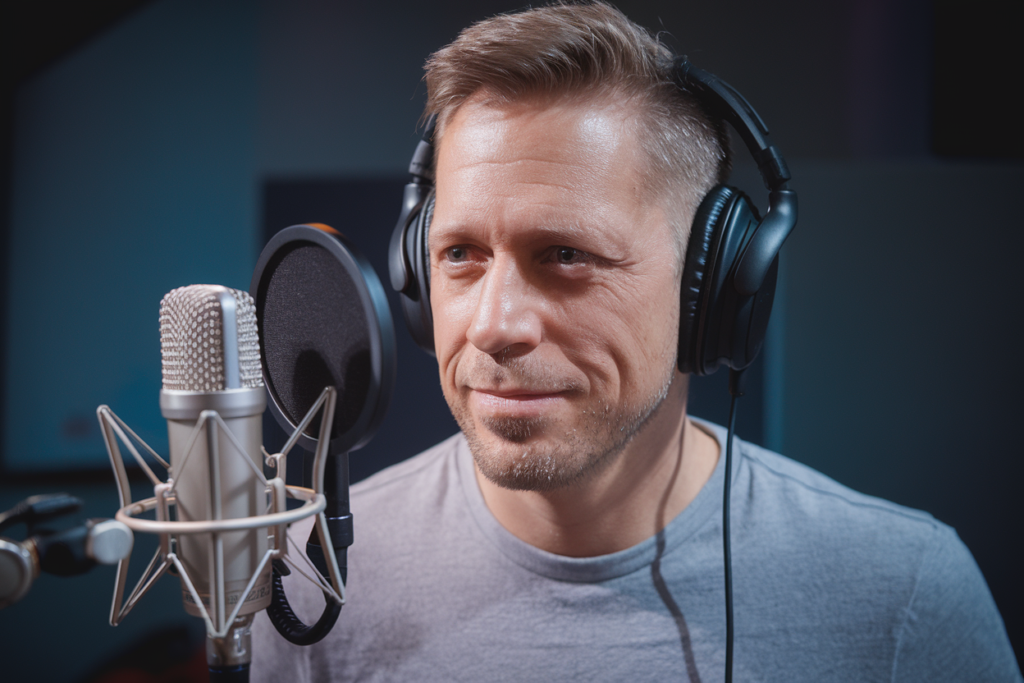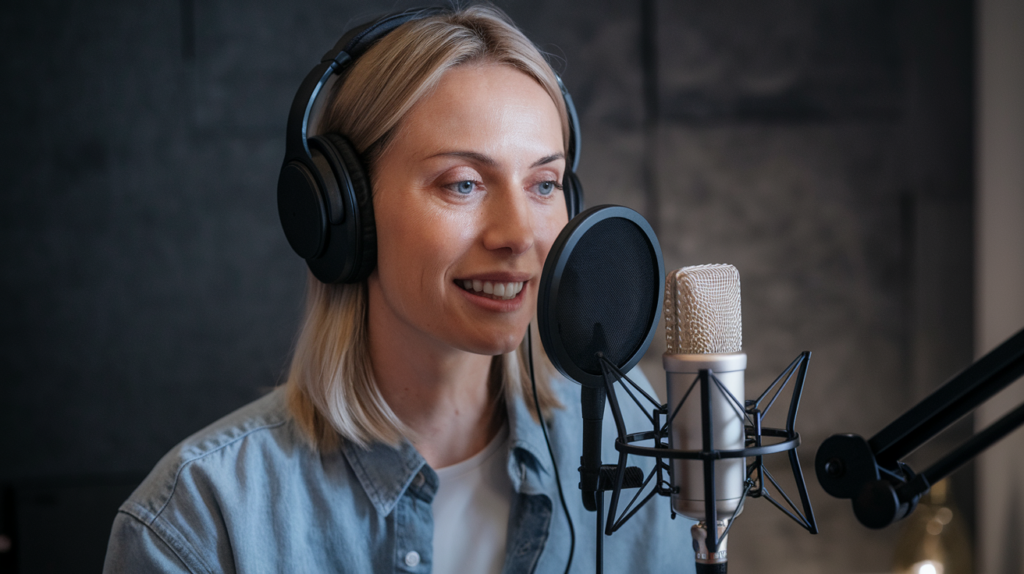Key Takeaways
- Understand the German Voice Acting Scene: Familiarity with regional dialects and cultural nuances enhances your directing effectiveness, leading to more authentic performances.
- Types of Voice Acting: Recognize various types of voice acting in Germany—commercials, dubbing, narration, and animation—to choose the appropriate direction for each project.
- Establish Clear Communication: Use straightforward language and provide specific expectations during sessions to foster a collaborative atmosphere with voice actors.
- Build Trust and Rapport: Creating a supportive environment helps voice artists feel valued, which can lead to more compelling and authentic performances.
- Prepare Thoroughly for Recording Sessions: Focus on script accuracy and create an optimal recording environment to ensure high-quality recordings from voice talent.
- Monitor Performance During Sessions: Provide immediate feedback and encourage emotional exploration to enhance authenticity in voiceovers.
Ever wondered how to direct German voice actors effectively? It can be a challenge, especially if you’re not familiar with the nuances of the language or culture. But don’t worry—you’re not alone in this!
Understanding the German Voice Acting Scene
Grasping the nuances of the German voice acting scene enriches your understanding of directing voiceovers. It helps you connect with voice actors more effectively, leading to better performances.
Importance of Cultural Context
Cultural context plays a vital role in voice acting. Germany boasts diverse dialects and regional accents that influence performance styles. Familiarity with these variations can enhance your direction and help you communicate clearer expectations. For instance, a voice actor from Bavaria may approach a character differently than one from Berlin. Recognizing these subtleties allows you to tailor your direction, ensuring authentic portrayals that resonate with audiences.
Types of Voice Acting in Germany
Germany offers various types of voice acting suited for different projects. Here are some common categories:
- Commercial Voice Overs: These include advertisements for radio, TV, and online platforms. They often require engaging tones to capture attention.
- Dubbing: This involves translating foreign films or shows into German while maintaining lip-syncing accuracy. A skilled voice artist brings characters to life by matching their emotional delivery.
- Narration: Documentaries or audiobooks rely on clear articulation and pacing from voice over talent to convey information effectively.
- Animation: Characters in animated features require unique voices that reflect their personalities. Creativity is crucial here; think about how distinct each character’s traits must be voiced.
Understanding these types will enable you to choose the right approach when directing your chosen German voice actors, leading to impactful results that elevate your project’s overall quality.
Key Techniques for Directing
Directing German voice actors involves a blend of clear communication and relationship-building. Understanding these techniques enhances performances and creates an engaging atmosphere.
Establishing Clear Communication
Clear communication is essential when directing voice actors. Use straightforward language, avoiding jargon that might confuse them. Specify your expectations for the performance, whether it’s tone, pace, or emotion. Provide examples or references to illustrate what you envision. Encouraging questions fosters a collaborative environment where voice talent feels comfortable seeking clarification. Regular feedback during sessions helps refine their delivery and aligns with your project goals.
Building Trust and Rapport with Actors
Building trust and rapport with voice artists leads to better performances. Take time to get to know them as individuals; this connection can significantly impact their comfort level in the studio. Show appreciation for their craft by acknowledging their skills and contributions throughout the process. Create a supportive atmosphere where they feel valued, which encourages authentic portrayals in their work. Remember, a relaxed actor often delivers more compelling performances, making your direction more effective overall.
Preparing for the Recording Session
Preparing for a recording session sets the stage for successful outcomes. A little groundwork can make all the difference in capturing that perfect performance from your voice actor.
Script Preparation and Translation
Start with a well-structured script that’s tailored to the German audience. Ensure accurate translation, considering cultural nuances and regional dialects. A word-for-word translation may miss vital context; instead, aim for a localized version that resonates with listeners. Collaborate closely with translators who understand these subtleties, ensuring your voice talent feels comfortable delivering authentic performances.
Review the script thoroughly before the session, marking any sections needing emphasis or specific emotions. Clear instructions help guide your voice artist on pacing and tone, ultimately enhancing their delivery.
Setting Up the Recording Environment
Create an optimal recording environment to boost sound quality and minimize distractions. Choose a quiet space equipped with proper soundproofing materials to eliminate background noise—this helps your voice over talent focus solely on their performance.
Ensure all technical equipment is functioning correctly before starting. This includes microphones, headphones, and recording software. Test everything in advance; you don’t want hiccups during the actual session disrupting flow.
Consider lighting as well; while it might seem secondary in audio work, good lighting helps set an inviting atmosphere for your voice actors. A relaxed setting encourages better performances—when they feel at ease, they deliver more genuine results.
By focusing on script preparation and environmental factors, you lay a solid foundation for effective sessions that yield high-quality recordings every time.
Directing During the Session
Directing voice actors during a session is crucial for achieving the desired performance. Effective communication and engagement can make all the difference in capturing that perfect take.
Monitoring Performance and Adjusting Direction
Monitor your voice actor’s performance closely. Pay attention to tone, pacing, and emotional delivery. If something feels off, don’t hesitate to provide immediate feedback. Phrasing your notes positively encourages growth; for example, saying “Try adding more warmth” rather than pointing out flaws keeps the atmosphere collaborative. Adjust direction as needed; sometimes a small tweak can lead to significant improvements. Use playback options to highlight successful moments or areas needing adjustment—this instant feedback loop helps refine performances on-the-fly.
Encouraging Emotional Range and Authenticity
Fostering emotional range is vital for authenticity in voiceovers. Encourage your voice actor to explore different emotions throughout the session. Ask open-ended questions like “How would you feel in this situation?” or “What’s going through their mind right now?” This approach allows them to connect deeply with their character or script. Create an environment where they feel comfortable experimenting with their delivery; a relaxed atmosphere often leads to more genuine performances. Remind them that vulnerability can enhance connection with listeners, making each line resonate more powerfully.
By focusing on these aspects during sessions, you create a productive space that yields remarkable results from your voice talent.
Post-Recording Considerations
Post-recording involves crucial steps to ensure the performance meets project standards. This phase focuses on refining audio quality and enhancing the overall delivery of voiceover talent.
Editing and Finalizing the Performance
Editing plays a vital role in polishing the final product. You or your team should carefully review each recording, cutting out any unwanted pauses, mistakes, or distractions. Listen for consistency in tone and pacing across different segments. It’s essential to align the final mix with your project’s vision while maintaining clarity in every word spoken by the voice actor.
Consider adding sound effects or background music if it enhances the narrative. Always keep an ear out for any inconsistencies that may disrupt listener engagement. Once you finalize edits, listen again as a complete piece to ensure everything flows seamlessly.
Collaborating with Sound Engineers
Collaboration with sound engineers is key during this stage. They bring expertise in mixing and mastering audio files, ensuring optimal sound quality for distribution across various platforms. Discuss your specific needs with them; they can help achieve desired effects that elevate your project.
Provide clear feedback about what resonates well from previous sessions, allowing engineers to adjust levels accordingly. Regular communication streamlines adjustments, fostering an environment where both parties work toward a shared goal: delivering exceptional results that captivate audiences.
By focusing on these post-recording considerations, you enhance not only the voiceover product but also create a more engaging experience for listeners.
Conclusion
Directing German voice actors can be a rewarding yet challenging experience. By embracing the cultural nuances and diverse dialects of the language, you’ll create a more authentic connection with your talent. Effective communication and relationship-building are key to fostering an environment where actors feel comfortable exploring their performances.
Preparation is crucial for success in recording sessions. A well-structured script and optimal recording conditions lay the groundwork for impactful results. Remember to monitor performances closely during sessions while providing constructive feedback that encourages emotional depth.
After recording, collaborating with sound engineers ensures your final product meets high standards. By paying attention to every detail throughout the process, you’ll elevate your projects and deliver captivating experiences that resonate with audiences.
Frequently Asked Questions
What are the main challenges of directing German voice actors?
Directing German voice actors can be challenging due to language barriers and cultural nuances. Understanding regional dialects and accents is essential for effective direction, as these variations influence performances. Directors may feel overwhelmed but knowing that many share similar experiences can be reassuring.
Why is understanding cultural context important in voice acting?
Cultural context enriches the directing process by helping directors tailor their guidance to fit the unique traits of German voice actors. Familiarity with local customs, dialects, and expressions leads to more authentic portrayals, enhancing overall performance quality in projects.
What types of voice acting are prominent in Germany?
In Germany, notable types of voice acting include commercial voiceovers, dubbing for films and series, narration for documentaries or audiobooks, and animation. Each type requires specific techniques and approaches to achieve impactful results tailored to its audience.
How can directors enhance communication with voice actors?
Directors should prioritize clear communication by using straightforward language and specifying performance expectations. Encouraging questions fosters a collaborative environment where actors feel comfortable expressing concerns or seeking clarification during sessions.
What preparation is needed before a recording session?
Successful recording sessions require well-structured scripts that resonate with the German audience. Collaborating with translators ensures accurate localization while reviewing scripts beforehand helps mark sections for emphasis. Clear instructions on pacing and tone also aid in guiding performances effectively.
How can directors create an optimal recording environment?
To boost sound quality during recordings, choose a quiet space with proper soundproofing to minimize distractions. Ensuring all technical equipment functions correctly is vital for capturing high-quality audio without interruptions or disturbances during the session.
What should directors focus on during a recording session?
During recording sessions, directors must monitor performances closely while providing immediate feedback. Encouraging emotional range allows actors to explore different feelings authentically, creating a comfortable atmosphere that enhances character connection and overall delivery quality.
What post-recording steps are crucial for project success?
Post-recording involves editing audio files to refine quality by cutting unwanted pauses and ensuring consistency in tone and pacing. Collaborating with sound engineers plays a key role in mixing and mastering audio files for optimal distribution results that engage listeners effectively.







